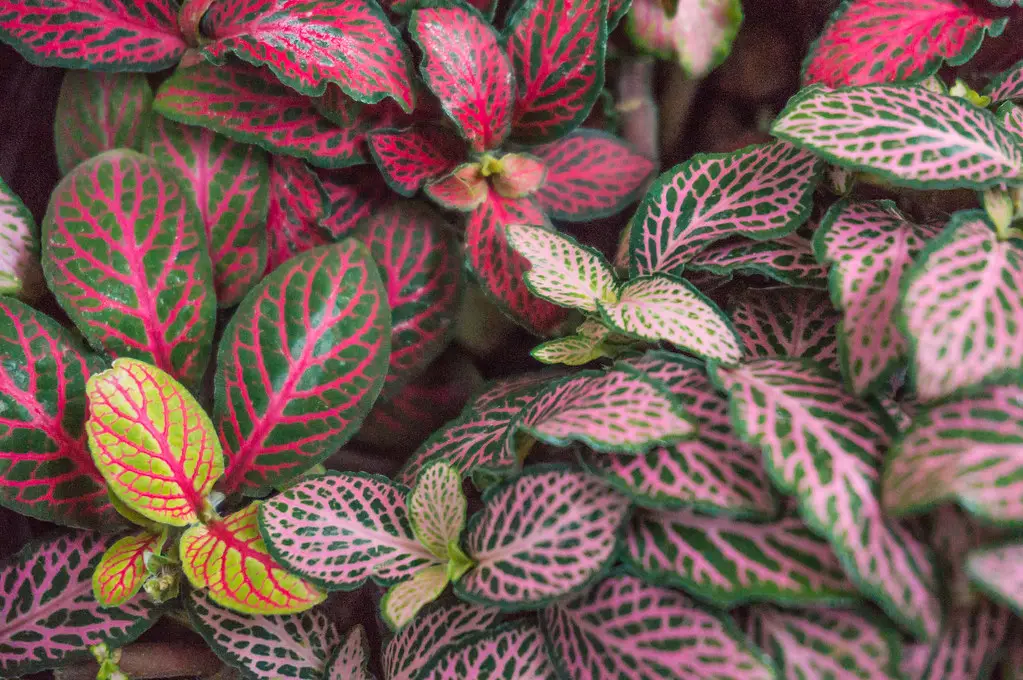Fittonia, also known as nerve plant or mosaic plant, is a delightful houseplant known for its striking patterned foliage. Originating from the tropical rainforests of South America, Fittonia’s lush green leaves are veined with bright white, pink, or red, adding a touch of color and texture to any indoor setting. The plant’s ornamental appearance has made it a popular choice among interior designers, plant enthusiasts, and even those new to gardening.
Despite its exotic appearance, Fittonia is relatively easy to care for, making it an attractive option for novice gardeners. Its small size and ability to thrive in indirect light make it a perfect fit for terrariums, fairy gardens, or tabletop displays. With a little attention to its specific care needs, Fittonia can be a long-lasting and attractive addition to your home or office.
What’s particularly appealing about Fittonia is its responsiveness to its environment. The leaves might wilt if the plant is thirsty, providing a visual clue about its needs. Plus, Fittonia’s non-toxic nature makes it a safe choice for homes with pets and children. With proper care, this charming plant can thrive and bring vibrant visual interest to any indoor space.
| Attribute | Details |
|---|---|
| Common Names | Fittonia, Nerve Plant, Mosaic Plant |
| Botanical Name | Fittonia albivenis |
| Family | Acanthaceae |
| Plant Type | Perennial Herb |
| Mature Size | 3-6 inches in height, 12-18 inches in spread |
| Sun Exposure | Indirect, filtered light |
| Soil Type | Peat-based soil mix |
| Hardiness Zones | 11 |
| Native Area | South America |
Fittonia Care
Fittonia’s care requirements reflect its native tropical habitat. It prefers humid environments and needs regular watering but not direct sunlight. Despite its delicate appearance, Fittonia is relatively forgiving and can recover from occasional lapses in care.
Its preference for a humid environment makes it well-suited for terrariums, bathrooms, or kitchens. Regular misting or placing the plant on a water-filled tray with pebbles can provide the humidity it craves. Watering should be done consistently to keep the soil moist, but not soggy.
Light Requirement for Fittonia
Fittonia thrives in indirect, filtered light. Direct sunlight can scorch the leaves, leading to discoloration or drying. A north or east-facing window, or a shaded spot away from direct sun, is usually ideal for this plant.
Soil Requirements for Fittonia
A peat-based soil mix that retains moisture yet drains well is ideal for Fittonia. A mixture of peat moss with sand or perlite can create a suitable environment, providing the right balance of water retention and drainage.
Water Requirements for Fittonia
Regular watering to keep the soil consistently moist is essential for Fittonia. However, overwatering that leads to waterlogged soil can cause root rot. Watering should be done when the top inch of soil feels dry, and the plant’s responsive wilting can provide a visual clue.
Temperature and Humidity
Fittonia prefers a temperature range between 60-75°F (15-24°C) and appreciates high humidity levels. Sudden temperature drops or exposure to cold drafts can be harmful. Humidity trays or regular misting can help maintain the desired humidity.
Fertilizer
A balanced, water-soluble fertilizer applied every 4-6 weeks during the growing season can support Fittonia’s growth. Avoiding over-fertilizing is essential, as it can lead to salt buildup and potential leaf damage.
Pruning Fittonia
Pruning can be done to control size or encourage bushier growth. Pinching back the tips or cutting back leggy stems with clean, sharp scissors can help maintain the desired shape.
Propagating Fittonia
Fittonia can be easily propagated through stem cuttings or leaf cuttings with a vein attached. Placing the cuttings in moist soil or water can encourage rooting.
How To Grow Fittonia From Seed
Growing Fittonia from seed is a more complex and slow process. Sowing the tiny seeds in a well-draining mix and maintaining a humid environment can lead to germination, but patience and careful attention are required.
Common Pests & Plant Diseases
Aphids
Aphids can be controlled through regular inspection and treating with insecticidal soap or neem oil.
Spider Mites
Spider mites may appear in dry conditions, so maintaining humidity can prevent infestation.
Common Problems With Fittonia
Wilting
Wilting can signal under-watering. Regular watering and avoiding dry soil can solve this problem.
Leaf Drop
Leaf drop may be due to cold drafts or sudden temperature changes. Ensuring a stable environment can prevent this issue.
Yellowing Leaves
Yellowing leaves can be a sign of overwatering. Ensuring proper drainage and avoiding soggy soil can alleviate this problem.
Pro Tips
- Place Fittonia in a humid room or use humidity trays to maintain moisture.
- Avoid direct sunlight to prevent leaf scorching.
- Use well-draining soil and water regularly without over-saturating.
- Prune to shape the plant or encourage bushier growth.
- Pay attention to visual cues, such as wilting, to understand the plant’s needs.




